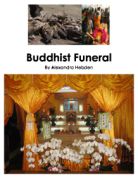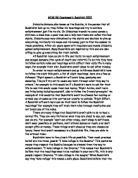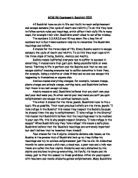The Tibetan Buddhists traditionally read the Bardo Thodol to the dying to prepare them
for the passage into their next life. Monks carry on saying the Bardo Thodol for 49 days after the death to help the Anatta on its way. In the Tibetan Buddhists views they traditionally cremate the body of the dead like the Theravada Buddhists, however as the Tibetan Buddhists are based in countries with usually scarce amounts of fuel, and wood so the body is given a ‘Sky Burial’.
Three days after the death, the body is washed and put into the foetal position so that it
leaves the world as it arrived; it is then wrapped in a white cloth, the white representing
purity. It is the taken to a top of a hill, an area walled off which is usually near a
monastery. As the body is taken the monks would chant, and the body would be
disposed off at dawn. For a ‘sky burial’ the body is then unwrapped and a body-breaker
craves the body into pieces, then it is mixed with flour, this will act as food for the
Vultures. Tibetan Buddhists believe that the body is then taken to Bardo. Bardo is believed to be ‘A human soul between the stages of after-death and rebirth.’ (1)
The Mahayana Buddhists are mainly based in China, the day of the death is very important to them, they believe that as soon as the body is taken the personality goes into a trance for four days in the trance the person does not know if he or she is alive or dead, the Mahayana Buddhists call this period the Bardo, and though out this period monks say special verses. Some of the most important readings that are recited are the Amitabha Sutra and the name of Amitabha.
The Mahayana Buddhists also believe that during this period the dead person will see a brilliant light, if it does not scare them, and they can welcome it then they no longer need to be re-born, however most people run away from the light which then fades.
The person then relieves that that they have died, and enter the second Bardo, they see everything that they have ever done, or thought. They also think that they have a body, they later relies that they do not, and enter the third Bardo, which is a state in which they search for a another body.
- ways morning periods observed
- prayers
- offerings
AO2: Explain how beliefs about life after death might affect the life of a Buddhist.
Buddhist believe in Karma; Karma is everything that you have ever done I your whole life, added up when you die and then weighed. If you have more good Karma then bad Buddhists believe that in your next life you will have a better life then the one that you just lived, how ever if you have more bad Karma then good karma you will be re-born in to a worse life. How great you life can be judged on many points, your family, friends, how wealthy you are, any disabilities, your home, some Buddhists even say that it can determine how pretty you are when you are re-born.
This is all decided when you die and enter the second stage of Bardo; Bardo is a place between death and being re-born. Most Buddhist are believed to just be re-born, however there are Buddhists that have reached the end of being re-born, and karma, they enter Nirvana, enlightenment, which is the ultimate aim for all Buddhists. This teaches Buddhists that their lives are in their hands, they can improve it or not.
So, Buddhists try to make as much good karma as they can, to reach enlightenment. They do this by following the 10 precepts, which consist of, not killing or harming any living thing, not stealing, not to misuse sex, not to lie and not to cloud the mind with alcohol or drugs, a Buddhists mind should at all times be clear so they can concentrate on reaching enlightenment. The other 5 precepts are not quite as widely practiced, it is usually monks that practice these continually, but are still very important. They are to refrain from eating after midday, to refrain from dancing, singing, or watching unsuitable entertainment. They should also try not to use scents or garlands, they should not sleep on a high or luxurious bed, and they should not touch gold, silver or handle money.
Another way Buddhists can reach enlightenment is by following the 8 fold path, the 8fold path has three sections, the way of wisdom, the way of morality and the way of mental training. The way of wisdom teaches Buddhists a “true insight and deep understanding of lie.” (3) The way of morality teaches them how to “behave towards other people and the environment”. (3) Whist the way of mental training teaches them the “spiritual practices that the Buddha can perform in order to reach Nibbana.” (3) Under these headings they have the 8 points of the 8 fold path that they must follow, they are having the right view, the right intentions, the right speech, the right action, the right livelihood, the right effort, the right meditation and the right mindfulness. If a Buddhist follows the rules of the 8 Fold Path, then he is on his way to making himself a better Buddhist, not only this, but the more he or she practices the 8 Fold Path the closer they get to reaching enlightenment which is their ultimate aim. By following these rules, they allow them selves to enter a state of mind, which "Makes the mind still and steady...opens vast vistas of bliss, serenity and power," and helps them to "generate the insights unveiling the ultimate truth of things." (2).
WEBSITES
-BBC bitesize
-wikipedia
-Google define
(1)
(2)
(3) class book rem. To add details







